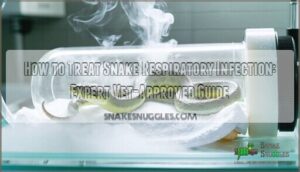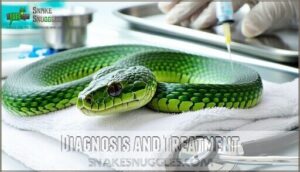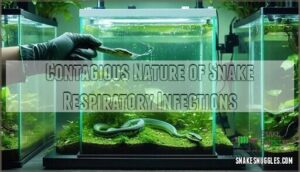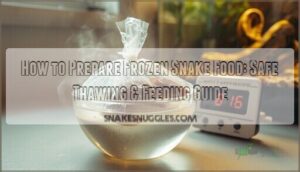This site is supported by our readers. We may earn a commission, at no cost to you, if you purchase through links.
 When you notice your snake wheezing, mouth-breathing, or producing mucus, it’s time to act fast.
When you notice your snake wheezing, mouth-breathing, or producing mucus, it’s time to act fast.
To treat snake respiratory infection effectively, you’ll need a vet’s help – these aren’t DIY fixes. Your reptile veterinarian will likely prescribe antibiotics and may recommend nebulization therapy, which is like giving your snake a medicated steam bath.
While treatment runs its course, bump up the heat in your snake’s enclosure slightly and maintain proper humidity levels. Think of it as creating a cozy recovery room.
Don’t skip meals either – sick snakes need nutrition to bounce back. The right combination of medical care and environmental tweaks makes all the difference in recovery speed.
Table Of Contents
- Key Takeaways
- Recognizing Snake Respiratory Infection Symptoms
- Diagnosis Methods for Snake Respiratory Infections
- Importance of Veterinary Guidance in Snake RI Treatment
- Antibiotics as Mainstay in Snake Respiratory Infection Treatment
- Nebulization Therapy for Snake Respiratory Infections
- Rest and Proper Husbandry for Snake Recovery
- Home Care Tips for Snake Respiratory Infections
- Monitoring and Managing Nutrition for Infected Snakes
- Contagious Nature of Snake Respiratory Infections
- Preventing Snake RI Through Habitat and Health Maintenance
- Frequently Asked Questions (FAQs)
- How do you treat a respiratory infection in a snake?
- How can I stop a viral nasal infection?
- Are there medical treatments for respiratory diseases in snakes?
- Do snakes have respiratory infections?
- How do you get rid of a respiratory infection in a snake?
- What medication is used for respiratory infection in snakes?
- What does a respiratory infection look like on a snake?
- How much does it cost to treat a respiratory infection in a snake?
- Can I treat my snakes respiratory infection at home?
- What causes snake respiratory infections?
- Conclusion
Key Takeaways
- Don’t attempt DIY treatment – You’ll need a reptile veterinarian’s expertise for proper antibiotics and diagnosis since respiratory infections can quickly become life-threatening without professional medical intervention.
- Act fast when you spot symptoms – If you notice wheezing, mouth-breathing, or mucus around your snake’s nose and mouth, contact your vet immediately since early treatment dramatically improves recovery outcomes.
- Create an optimal recovery environment – Maintain proper temperature gradients (88-92°F basking, 78-82°F cool side) and 50-60% humidity while keeping the enclosure spotlessly clean to support your snake’s healing process.
- Combine medical treatment with supportive care – Follow your vet’s antibiotic protocol while providing nebulization therapy if recommended, ensuring proper hydration, and minimizing stress through reduced handling during recovery.
Recognizing Snake Respiratory Infection Symptoms
You’ll know something’s wrong when your snake starts wheezing, mouth-breathing, or showing bubbly mucus around its nose and mouth – think of it like a reptilian version of a stuffy nose that just won’t quit.
When your snake sounds like a tiny tea kettle wheezing, it’s time to call the vet immediately.
Early detection can mean the difference between a quick recovery and a serious health crisis, so don’t ignore these warning signs when your scaly friend seems off, as it can lead to a serious health crisis.
Snake Respiratory Symptoms
You’re watching your snake, and something feels off. Those snake respiratory infection symptoms aren’t just in your head.
When your scaly friend develops snake breathing problems, the early indicators are pretty clear if you know what to look for.
Here’s what screams "respiratory trouble":
- Open-mouth breathing – like they’re gasping for air at the surface
- Wheezing or clicking sounds – your snake shouldn’t sound like a tiny tea kettle
- Mucus around the nose or mouth – sticky, bubbly discharge is never normal
- Behavioral changes – hiding more, moving less, or seeming unusually sluggish
- Appetite changes – refusing food when they’d normally strike
Consider snake wheezing treatments available online.
Don’t mistake shedding mimicry for illness.
Diagnosis and Treatment
The moment you spot respiratory symptoms, time becomes your snake’s best friend.
Quick snake diagnosis through diagnostic tests can mean the difference between recovery and tragedy. Your vet will use imaging techniques like X-rays to peek inside your snake’s respiratory system and pinpoint the problem.
Treatment typically involves:
- Antibiotics targeting bacterial infections with vet supervision
- Supportive care including medication types that reduce inflammation.
Recovery time varies, but early snake treatment dramatically improves outcomes.
Home Care
Caring for a snake respiratory infection at home requires dedication alongside professional treatment. You can’t cure the infection with snake home remedies alone, but proper home care makes a real difference in your pet’s recovery journey.
Remember: your snake’s life depends on quick action when you spot those first wheezing sounds.
Essential Home Care Elements:
| Care Area | Action Required | Benefit |
|---|---|---|
| Temperature | Maintain ideal heat gradients | Boosts immune function |
| Hydration methods | Provide fresh water, gentle soaks | Thins mucus secretions |
| Quarantine setup | Isolate affected snake | Prevents spread to others |
Focus on stress reduction by keeping handling to a minimum. Soak benefits include improved hydration and easier breathing—think of it as a snake spa day! Monitor appetite stimulation carefully, as sick snakes often refuse food.
Remember, these home treatment steps support your vet’s prescribed snake respiratory treatment plan. They’re not replacements for professional care. If symptoms worsen despite your best efforts, contact your reptile veterinarian immediately. Your snake’s counting on both medical expertise and your attentive home care.
Diagnosis Methods for Snake Respiratory Infections
Once you’ve spotted the telltale signs of respiratory trouble in your snake, you’ll need a proper diagnosis to confirm what’s really going on inside those tiny lungs.
Your vet will use a combination of hands-on exams, X-rays, and lab tests to pinpoint the exact cause and create the right treatment plan for your scaly friend.
Physical Exams and X-rays
When your snake shows breathing trouble, your vet’s physical exam and X-rays become detective tools for early detection.
During the internal assessment, vets check breathing patterns, listen for unusual sounds, and examine overall health. Snake X-rays reveal lung abnormalities like fluid buildup or inflammation that aren’t visible externally.
These imaging techniques offer significant imaging benefits for snake respiratory infection diagnosis, though exam limitations exist. Diagnostic imaging shouldn’t be your only guide—it works best combined with other tests.
To further assess the snake, vets might also perform an arterial blood gas analysis. While snake imaging techniques are generally safe, discuss costs and concerns with your veterinarian beforehand.
Laboratory Tests and Cultures
Precision becomes your ally when diagnosing snake respiratory infections through laboratory testing.
Your vet will collect samples using sterile techniques to identify the exact culprit behind your snake’s illness.
- Sample collection from respiratory secretions, blood work, and fecal sample evaluation provides thorough pathogen identification
- Culture types grow bacteria in controlled environments, revealing which microorganisms are causing trouble
- Sensitivity testing determines which antibiotics will actually work against the specific bacteria found
Snake lung washes and pathogen testing offer detailed insights into your pet’s condition.
The microbiology lab’s role is critical in infectious disease diagnosis.
Results interpretation guides targeted treatment plans, ensuring your snake gets the right medication instead of guessing games.
This scientific approach beats trial-and-error every time.
Importance of Veterinary Guidance in Snake RI Treatment
When treating your snake’s respiratory infection, getting professional veterinary care isn’t just recommended—it’s absolutely essential. You wouldn’t diagnose your own pneumonia, so don’t attempt to tackle your snake’s breathing problems alone.
A qualified reptile veterinarian brings Expert Diagnosis skills that can’t be googled. They’ll perform thorough examinations, identify the specific pathogen causing trouble, and create Tailored Treatment plans for your snake’s unique situation.
This isn’t a one-size-fits-all scenario. Medication Management requires precise dosing based on your snake’s weight and condition. Too little won’t work; too much could be dangerous. Your reptile vet knows exactly what your scaly friend needs.
Professional snake vet care focuses on Preventing Complications that could turn a manageable infection into something life-threatening. They’ll monitor progress, adjust treatments, and guarantee your snake’s Long-term Health. Think of your vet as your snake’s breathing coach—guiding you both toward a full recovery.
Antibiotics as Mainstay in Snake Respiratory Infection Treatment
When your vet prescribes antibiotics for snake respiratory infection, you’re getting the gold standard treatment. These prescription antibiotics pack a serious punch against bacterial infections, but they’re not candy—proper antibiotic treatment requires careful handling.
Here’s what you need to know about snake antibiotics:
- Dosage Calculation: Your vet calculates the exact amount based on your snake’s weight, typically 20-50 mg/kg for most snake RI treatment protocols.
- Injection Techniques: Most antibiotics work better through injections rather than oral routes, ensuring better absorption and faster results.
- Treatment Duration: Complete the full 10-14 day course, even if symptoms improve—stopping early invites antibiotic resistance. To improve outcomes, supportive care is essential during treatment.
- Alternative Antibiotics: Enrofloxacin, ceftazidime, and azithromycin offer different options if your snake doesn’t respond to the first choice.
Nebulization Therapy for Snake Respiratory Infections
While antibiotics work from the inside out, nebulization therapy offers a direct route to your snake’s respiratory system.
Think of it as delivering medicine right where it’s needed most.
This treatment uses medical-grade nebulizer types to create a fine mist of medication your snake can breathe.
It’s particularly effective for snake respiratory infections caused by fungal pathogens like Ophidiomyces ophiodiicola.
The medication delivery system works by suspending antifungal drugs like terbinafine in water, creating a therapeutic vapor.
Treatment duration varies based on your snake’s condition severity.
You’ll need professional veterinary equipment – regular humidifiers won’t cut it for proper nebulization.
Some owners purchase nebulization therapy products for home use.
The setup must maintain proper humidity control while minimizing snake stress through minimal handling.
Nebulization therapy serves as an excellent expectorant, helping clear stubborn respiratory discharges.
It’s especially valuable for venomous species where handling poses additional risks.
This snake respiratory treatment complements systemic antibiotics, giving your pet the best chance at recovery.
Rest and Proper Husbandry for Snake Recovery
While nebulization therapy helps clear your snake’s airways, creating the right recovery environment is equally important for beating a snake respiratory infection. Think of it like setting up a healing sanctuary where your pet can bounce back stronger.
Your snake’s enclosure becomes their personal recovery room during this time.
Here’s how to optimize snake recovery conditions:
- Maintain perfect snake temperature gradients – Keep basking spots at 88-92°F and cool sides at 78-82°F
- Control snake humidity levels – Aim for 50-60% humidity to support breathing without encouraging bacterial growth
- Create a quiet environment – Minimize loud noises, vibrations, and frequent handling
- Focus on enclosure cleaning – Disinfect weekly with reptile-safe cleaners to prevent reinfection
- Support natural shedding cycles – Proper humidity helps if your snake needs to shed during recovery
Stress reduction plays a huge role in immune system function. You’ll want to resist the urge to constantly check on them – sometimes the best medicine is simply leaving them alone to rest and heal naturally.
Home Care Tips for Snake Respiratory Infections
Your snake’s comfort becomes your top priority when dealing with a respiratory infection. Think of yourself as their personal caregiver, creating the perfect healing environment at home.
Essential home treatment steps include:
- Hydration methods: Provide shallow, lukewarm water dishes and gentle warm soaks twice weekly to keep airways moist and support recovery
- Enclosure cleaning: Disinfect the habitat weekly with reptile-safe cleaners, removing waste immediately to prevent bacterial buildup that worsens snake respiratory symptoms
- Stress reduction: Minimize handling, maintain consistent temperatures, and create quiet hiding spots where your snake feels secure during snake respiratory treatment
Keep humidity between 50-60% using a reliable hygrometer. Clean water bowls daily and spot-clean any mess immediately. Your snake’s immune system works better in a pristine environment. Remember, consistency in snake care routines helps reduce stress levels, allowing your pet to focus energy on fighting the infection naturally.
Monitoring and Managing Nutrition for Infected Snakes
When your snake’s fighting a respiratory infection, nutrition becomes your secret weapon for recovery.
These sick reptiles often lose their appetite, making weight monitoring and feeding techniques essential for their survival.
- Weight Monitoring: Check weekly to track nutritional status and recovery progress
- Appetite Stimulation: Offer favorite prey items or use scent to encourage feeding
- Hydration Methods: Provide fresh water and monitor skin elasticity for dehydration signs
- Feeding Techniques: Reduce prey size to 50-75% of normal during illness
- Supplementation Strategies: Add vitamins and protein under veterinary guidance
- Force Feeding: Only attempt with proper vet supervision and training
Contagious Nature of Snake Respiratory Infections
Respiratory infections spread fast among snakes through transmission routes like airborne droplets and contaminated surfaces.
You’ll need strict quarantine protocols when one snake shows symptoms—infectious agents don’t discriminate. Bacterial infections and viral infections can jump between enclosures through shared tools or your hands.
Some species show higher species susceptibility, making environmental spread more likely in collections. While zoonotic potential exists with certain pathogens, proper hygiene keeps you safe.
Transmission happens quickly in close quarters, so isolate sick snakes immediately to protect your entire collection. Snakes can also transmit bacterial infections through bites.
Preventing Snake RI Through Habitat and Health Maintenance
While treating respiratory infections is essential, preventing them saves you heartache and your snake unnecessary suffering.
Proactive husbandry creates the foundation for snake respiratory infection prevention through consistent care and attention.
- Perfect Your Snake Enclosure Setup – Maintain proper temperature gradients and humidity levels specific to your species, ensuring your snake respiratory environment supports healthy breathing and immune function.
- Practice Strict Snake Hygiene – Clean water bowls weekly, spot-clean waste immediately, and deep-clean monthly to prevent bacterial buildup that causes infections.
- Implement Quarantine Protocols – Isolate new snakes for 60-90 days before introducing them to your collection, preventing disease transmission.
- Focus on Snake Stress Reduction – Provide adequate hiding spots, maintain consistent feeding schedules, and schedule regular checkups for immune boosting through early detection.
Frequently Asked Questions (FAQs)
How do you treat a respiratory infection in a snake?
Like fighting a cold that won’t quit, you’ll need antibiotics from a reptile vet, supportive care with proper heat and humidity, plus fluid therapy if severe.
Don’t delay—early treatment saves lives.
How can I stop a viral nasal infection?
Unfortunately, you can’t directly stop a viral nasal infection in snakes.
You’ll need to focus on supportive care like maintaining proper humidity, temperature, and cleanliness while consulting an exotic veterinarian immediately.
Are there medical treatments for respiratory diseases in snakes?
Yes, you’ll need antibiotics like enrofloxacin from a reptile vet for bacterial infections.
They might also prescribe anti-fungal medications, supportive fluid therapy, and nebulization treatments to help your snake breathe easier and recover faster.
Do snakes have respiratory infections?
Just like catching a cold, snakes absolutely get respiratory infections too.
You’ll notice wheezing, mouth breathing, mucus around their nose, and lethargy.
These infections need immediate vet attention since they’re serious.
How do you get rid of a respiratory infection in a snake?
You’ll need a reptile vet to prescribe antibiotics like enrofloxacin.
They’ll also provide supportive care including fluid therapy and temperature management.
Don’t wait – early treatment saves lives and prevents complications.
What medication is used for respiratory infection in snakes?
Veterinarians commonly prescribe enrofloxacin, ceftazidime, or azithromycin antibiotics for bacterial respiratory infections. You’ll also need anti-fungal medications like itraconazole for fungal cases, plus supportive treatments including fluids and anti-inflammatory drugs.
What does a respiratory infection look like on a snake?
Nearly 90% of untreated respiratory infections prove fatal in snakes.
You’ll spot open-mouth breathing, wheezing sounds, and bubbly mucus around the nose or mouth.
Your snake might seem lethargic and spend extra time basking near its heat source.
How much does it cost to treat a respiratory infection in a snake?
Treatment costs range from $150-$500, depending on your snake’s condition and required care.
You’ll pay for vet visits, diagnostic tests, antibiotics, and possible hospitalization.
Early treatment saves money and your snake’s life.
Can I treat my snakes respiratory infection at home?
Like trying to fix a car engine with a screwdriver, treating your snake’s respiratory infection at home isn’t wise. You’ll need a reptile vet’s expertise for proper antibiotics and care.
What causes snake respiratory infections?
Poor husbandry creates the perfect storm for respiratory infections in your snake.
Incorrect humidity, temperature fluctuations, dirty enclosures, and stress weaken their immune system.
Making them vulnerable to bacteria, viruses, and fungi is a direct result of these poor conditions, particularly bacteria.
Conclusion
Remember, "an ounce of prevention is worth a pound of cure," but when respiratory infections strike your snake, swift action saves lives.
Learning how to treat snake respiratory infection properly means partnering with your vet for antibiotics and nebulization therapy while creating the perfect recovery environment at home.
Don’t wait for symptoms to worsen—early intervention, proper husbandry, and consistent monitoring give your scaly friend the best shot at a full recovery, which is why proper husbandry is crucial.
- https://reptifiles.com/boa-constrictor-care/sick-boa/respiratory-infection/
- https://lafeber.com/vet/respiratory-disease-in-snakes/
- https://pmc.ncbi.nlm.nih.gov/articles/PMC4173777/
- https://www.merckvetmanual.com/multimedia/table/antimicrobial-drugs-used-in-reptiles
- https://www.youtube.com/watch?v=o-TP5YnaEyY



















